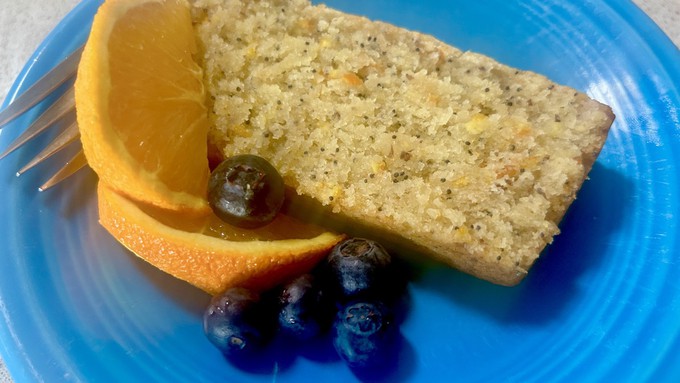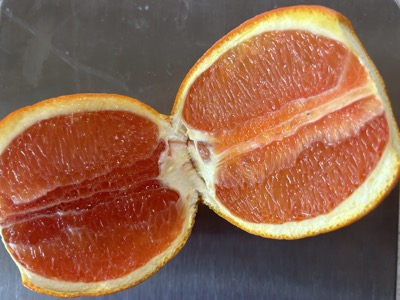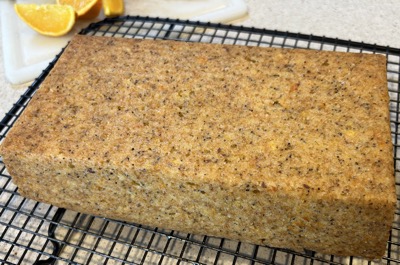
Recipe: Poppy seeds add texture to vegan snack cake

Poppy seeds and orange zest add visual interest to this moist orange loaf cake. Kathy Morrison
As citrus season rolls on through the end of winter, I felt the urge to bake something with oranges. Poking around online, I found a reference to "orange poppy lazy loaf" that led to Gretchen's Vegan Bakery.
I'm not a vegan cook, but I like to try plant-based recipes. Gretchen has a very active blog, and a wealth of recipes available, if vegan baking is your preference.

The orange loaf recipe is called "lazy," apparently, because the whole orange is used, skin and all, puréed in a food processor with all the other ingredients. (OK, not the stem or potential seeds, but everything else.)
I've make other whole-orange recipes before: The Almond & Orange Cake in our Taste Winter! cookbook is gluten- and dairy-free, though it uses 6 eggs, so definitely not vegan.
This recipe, unlike the other, doesn't require boiling the oranges first, but Gretchen warns to use oranges with thin skins (meaning less bitter pith), totaling about 5 ounces. I had one Cara Cara orange left that, minus the stem, weighed in at 5.1 ounces. Perfect. Mandarins or clementines also would be good choices.
I diverged from the original recipe in mixing and somewhat in ingredients. The primary difference is that she used Bob's Red Mill egg replacer, while I used a "flaxseed egg." The recipe here is my adaptation, which is less "lazy" but makes more sense to me.
Orange poppy seed snack loaf
Makes one 5-by-10-inch loaf
Ingredients:
3/4 cup non-dairy milk (I used oat milk)
1 tablespoon ground flaxseed
1 small navel orange or 2 small clementines, total weight about 5 ounces, stem end removed
1 scant cup granulated sugar (195 grams)
1/2 cup vegetable oil
2 teaspoons vanilla extract
1-3/4 cup unbleached all-purpose flour
3 teaspoons baking powder
3/4 teaspoon salt
2 teaspoons (or more) poppy seeds
Optional light* glaze:
1/2 tablespoon fresh orange juice
3 to 4 tablespoons powdered sugar
Instructions:
Grease a 5-by-10-inch loaf pan. Preheat oven to 350 degrees.
Measure the non-dairy milk into a 1 cup glass measuring cup. Stir in the ground flaxseed, and set aside.
Cut the orange in half or quarters to check for seeds. Remove any seeds and any thick interior stem. Place the orange pieces, with skin intact, in a food processor or blender. Add the granulated sugar and blend at high speed until the orange and sugar are puréed and well combined. (There will be small pieces of skin visible, which is OK.)
Scrape the orange mixture into a large bowl. Whisk in the oil, then the vanilla and the flaxseed-milk mixture.
In a medium bowl, whisk together the flour, baking powder, salt and poppy seeds. Blend the dry ingredients into the wet ingredients with a wooden spoon or rubber spatula, being careful not to over-mix.
Pour the batter into the prepared loaf pan. Bake for 40-45 minutes, or until a toothpick stuck in the middle of the loaf comes out clean.

Place the pan on a cooling rack, and let the loaf cool for about 10 minutes. Then remove it from the pan to the rack and allow to cool completely before glazing or serving.
*Note: I made a small amount of light glaze for the top of the loaf, but this is optional. If a thicker glaze is desired for a dessert presentation, combine 1 cup confectioner's sugar with 1 tablespoon fresh juice and 1-1/2 teaspoon orange zest. Garnish with orange slices and/or more poppy seeds, as desired.
Comments
0 comments have been posted.Sacramento Digs Gardening to your inbox.
Food in My Back Yard Series
May 6: Maintain soil moisture with mulch for garden success
April 29: What's (already) wrong with my tomato plants?
April 22: Should you stock up on fertilizer? (Yes!)
April 15: Grow culinary herbs in containers
April 8: When to plant summer vegetables
April 1: Don't be fooled by these garden myths
March 25: Fertilizer tips: How to 'feed' your vegetables for healthy growth
March 18: Time to give vegetable seedlings some more space
March 11: Ways to win the fight against weeds
March 4: Potatoes from the garden
Feb. 25: Plant a fruit tree now -- for later
Feb. 18: How to squeeze more food into less space
Feb. 11: When to plant? Consider staggering your transplants
Feb. 4: Starting in seed starting
Sites We Like
Garden Checklist for week of May 11
Make the most of the lower temperatures early in the week. We’ll be back in the 80s by Thursday.
* Plant, plant, plant! It’s prime planting season in the Sacramento area. Time to set out those tomato transplants along with peppers and eggplants. Pinch off any flowers on new transplants to make them concentrate on establishing roots instead of setting premature fruit.
* Direct-seed melons, cucumbers, summer squash, corn, radishes, pumpkins and annual herbs such as basil.
* Harvest cabbage, lettuce, peas and green onions.
* In the flower garden, direct-seed sunflowers, cosmos, salvia, zinnias, marigolds, celosia and asters. (You also can transplant seedlings for many of the same flowers.)
* Plant dahlia tubers.
* Transplant petunias, marigolds and perennial flowers such as astilbe, columbine, coneflowers, coreopsis, dahlias, rudbeckia and verbena.
* Keep an eye out for slugs, snails, earwigs and aphids that want to dine on tender new growth.
* Feed summer bloomers with a balanced fertilizer.
* For continued bloom, cut off spent flowers on roses as well as other flowering plants.
* Add mulch to the garden to maintain moisture. Mulch also cuts down on weeds. But don’t let it mound around the stems or trunks of trees or shrubs. Leave about a 6-inch-to-1-foot circle to avoid crown rot or other problems.
* Remember to weed! Pull those nasties before they set seed.
* Water early in the day and keep seedlings evenly moist.